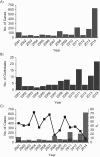Assessment of the Status of Measles Elimination in the United States, 2001-2014
- PMID: 28338902
- PMCID: PMC7110139
- DOI: 10.1093/aje/kww168
Assessment of the Status of Measles Elimination in the United States, 2001-2014
Abstract
We assessed the status of measles elimination in the United States using outbreak notification data. Measles transmissibility was assessed by estimation of the reproduction number, R, the average number of secondary cases per infection, using 4 methods; elimination requires maintaining R at <1. Method 1 estimates R as 1 minus the proportion of cases that are imported. Methods 2 and 3 estimate R by fitting a model of the spread of infection to data on the sizes and generations of chains of transmission, respectively. Method 4 assesses transmissibility before public health interventions, by estimating R for the case with the earliest symptom onset in each cluster (Rindex). During 2001-2014, R and Rindex estimates obtained using methods 1-4 were 0.72 (95% confidence interval (CI): 0.68, 0.76), 0.66 (95% CI: 0.62, 0.70), 0.45 (95% CI: 0.40, 0.49), and 0.63 (95% CI: 0.57, 0.69), respectively. Year-to-year variability in the values of R and Rindex and an increase in transmissibility in recent years were noted with all methods. Elimination of endemic measles transmission is maintained in the United States. A suggested increase in measles transmissibility since elimination warrants continued monitoring and emphasizes the importance of high measles vaccination coverage throughout the population.
Keywords: United States; measles; reproduction number; transmissibility.
Published by Oxford University Press on behalf of the Johns Hopkins Bloomberg School of Public Health 2017. This work is written by (a) US Government employee(s) and is in the public domain in the US.
Figures


References
-
- Katz SL, Hinman AR. Summary and conclusions: measles elimination meeting, 16–17 March 2000. J Infect Dis. 2004;189(suppl 1):S43–S47. - PubMed
-
- Fiebelkorn AP, Redd SB, Gallagher K, et al. . Measles in the United States during the postelimination era. J Infect Dis. 2010;202(10):1520–1528. - PubMed
-
- Centers for Disease Control and Prevention Measles—United States, 2011. MMWR Morb Mortal Wkly Rep. 2012;61:253–257. - PubMed
MeSH terms
Substances
LinkOut - more resources
Full Text Sources
Other Literature Sources
Medical

